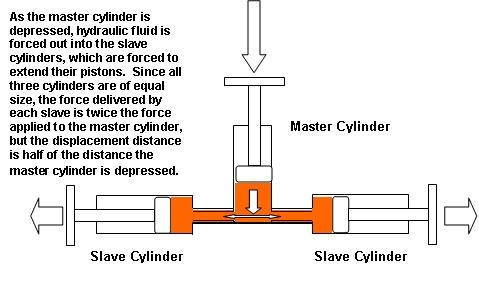
Slave cylinders are vitally important parts of hydraulic and pneumatic actuation and control systems. They are used in every industry and field of human endeavor including industrial, domestic, transportation, aerospace, medicine and recreation. As the name implies, slave cylinders act to lengthen or shorten themselves in response to an actuation pressure command coming from another device, called the master device of the system. There can be any number of slave cylinders in a system, although it is customary that there is usually only one master. There can be more either acting in parallel or in series.
By far, the most common use of the slave cylinder concept is in automotive braking systems. Ironically, in this application, they are not customarily called slave cylinders, as they are usually referred to as wheel cylinders for drum brake integrations and caliper cylinders in disc brake employments.
The first hydraulic braking systems in automobiles had one master hydraulic cylinder connected to a brake pedal. This was connected in parallel to four individual slave wheel cylinders, one at each wheel. Each wheel slave cylinder was configured with two pistons facing each other, with the pressure tap entering in the space between them. When the brake pedal was depressed, the master cylinder would be displaced negatively, and fluid forced into the brake lines that were connected to all four wheel cylinders. This pressure was applied to both pistons in each cylinder, forcing them out and away from each other, spreading the brake shoes to contact the brake drums to stop the car.
Vast improvements have been made to automotive brake systems such as dual master cylinders, diagonal braking, and anti-lock braking incorporating speed sensors at each wheel.
Many slave cylinder applications are in conjunction with a master cylinder located some distance away from them, on large machines, for example. In these applications, hydraulics can substantially reduce mechanical complexity and cost. If it is desired that whenever one part of the machine moves, that another should move with it, a master cylinder can be actuated by the first action, and the slave directly connected to exactly reproduce the action of the first.
An automotive bottle jack is a great example of multiplying force to a system by using a slave cylinder. There is a very small master cylinder attached to the jack handle, and another much larger one actually lifting the heavy load. Each time the handle is jacked, the large cylinder moves a much smaller distance, but with a proportionately much greater force. Thus, a relatively small person can eventually lift a heavy vehicle.